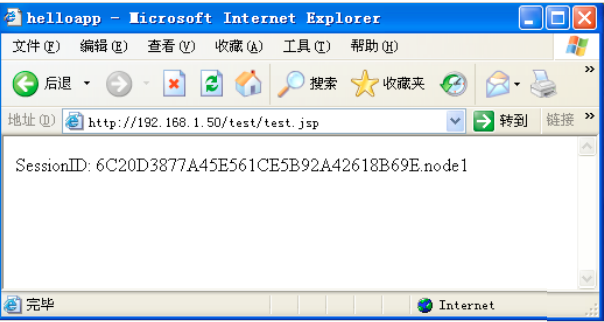Tomcat叢集配置筆記
一. 環境說明
1. 伺服器3 臺,一臺安裝apache 服務,兩臺安裝tomcat
2. 使用到的各個元件及下載地址:
apache_2.2.11-win32-x86-no_ssl.msi
tomcat 6 壓縮版
apache 的JK 聯結器(Windows 版本),作為apache 的一個module ,網站同時提供了配置檔案的使用方法
mod_jk-1.2.28-httpd-2.2.3.so
3.ip 配置
一臺安裝apache 的ip 為192.168.1.50 ,兩臺安裝tomcat 的ip 分別為192.168.1.24 和192.168.1.52 (根據各自情況分配)
二.安裝過程
1. 在兩臺安裝tomcat 的機器上安裝jdk6 (至少jdk5 )
2. 配置jdk 的安裝路徑, 在環境變數path 中加入jdk 的bin 路徑, 新建環境變數JAVA_HOME 指向jdk 的安裝路徑
3. 安裝tomcat ,並測試tomcat 的啟動是否正常
三.負載均衡配置過程
1. 在192.168.1.50 機器上安裝apache 服務,我的安裝路徑預設為:D:/Program Files/Apache Software Foundation/Apache2.2
2. 安裝完成後測試能否正常啟動,http://192.168.1.50 ,如圖所示:

3. 將mod_jk-1.2.28-httpd-2.2.3.so 拷貝到apache 的modules 目錄下
2. 修改apache 的配置檔案 httpd.cof ,在最後加上下面這段話:
LoadModule jk_module modules/mod_jk-1.2.28-httpd-2.2.3.so # 載入jk 聯結器
JkWorkersFile conf/workers.properties # 設定負載均衡的配置檔案,即定義均衡規則
JkLogFile logs/mod_jk.log # 指定日誌檔案
JkLogLevel debug # 指定日誌級別
#
配置apache 將哪些請求轉發給JK
JkMount /*.jsp loadbalancer
JkMount /test/* loadbalancer
3. 分別修改兩個tomcat 的配置檔案conf/server.xml 檔案
修改前:
<!-- An Engine represents the entry point (within Catalina) that processes
every request. The Engine implementation for Tomcat stand alone
analyzes the HTTP headers included with the request, and passes them
on to the appropriate Host (virtual host).
Documentation at /docs/config/engine.html -->
<!-- You should set jvmRoute to support load-balancing via AJP ie :
<Engine name="Catalina" defaultHost="localhost" jvmRoute="jvm1">
-->
<Engine name="Catalina" defaultHost="localhost">
修改後:
<!-- An Engine represents the entry point (within Catalina) that processes
every request. The Engine implementation for Tomcat stand alone
analyzes the HTTP headers included with the request, and passes them
on to the appropriate Host (virtual host).
Documentation at /docs/config/engine.html -->
<!-- You should set jvmRoute to support load-balancing via AJP ie : -->
<Engine name="Catalina" defaultHost="localhost" jvmRoute="node1">
<Engine name="Catalina" defaultHost="localhost" >
將其中的jvmRoute="jvm1" 分別修改為jvmRoute="node1" 和jvmRoute="node2"
4. 在apache 的conf 目錄下建立workers.property 檔案,輸入以下內容:
# fine the communication channel
# 定義負載均衡的所有主機名,和前面tomcat 配置檔案的JVMroute 屬性相對應
# 其中的loadbalancer 是虛擬的主機,負責負載均衡,姑且當成是apache 本身
worker.list=node1,node2,loadbalancer
# node1 使用AJP 與JK 通訊
worker.node1.port=8009 # 工作埠,若沒佔用則不用修改
worker.node1.host=192.168.1.24 # node1 的地址為localhost ,如果tomcat 在其他伺服器則輸入該伺服器的地址
worker.node1.type=ajp13 # 型別
worker.node1.lbfactor=100 # 負載平衡因數
worker.node2.port=9009 # 工作埠,若沒佔用則不用修改
worker.node2.host=192.168.1.52 #node2 伺服器的地址
worker.node2.type=ajp13 # 型別
worker.node2.lbfactor=100 # 負載因子,值越大則JK 分發到此tomcat 的負荷越多
# 定義loadbalancer 型別為“負載均衡器(lb )”
worker.loadbalancer.type=lb
# 定義loadbalancer 進行負載均衡的物件
worker.loadbalancer.balanced_workers=node1,node2
worker.loadbalancer.sticky_session=false
worker.loadbalancer.sticky_session_force=false
5. 在兩個tomcat 的安裝目錄中的webapps 建立相同的應用,我的應用名為test ,在兩個應用目錄中建立相同 WEB-INF 目錄和頁面test.jsp 的頁面內容如下
<%@ page language = "java" contentType = "text/html; charset=ISO-8859-1"
pageEncoding = "GBK" %>
<! DOCTYPE html PUBLIC "-//W3C//DTD HTML 4.01 Transitional//EN" "http://www.w3.org/TR/html4/loose.dtd" >
< html >
< head >
< meta http-equiv = "Content-Type" content = "text/html; charset=ISO-8859-1" >
< title > helloapp </ title >
</ head >
< body >
<%
System.out.println( "call test.jsp" ); // 在Tomcat 控制檯上列印一些跟蹤資料
%>
SessionID: <%= session.getId() %>
</ body >
</ html >
6. 重啟 apache 伺服器和兩個 tomcat 伺服器,到此負載均衡已經配置完成,測試負載均衡: 執行正常則已建立負載均衡
四.叢集配置
1. 負載均衡的條件下配置tomcat 叢集
2 .分別修改兩個tomcat 的配置檔案conf/server.xml, 修改內容如下
修改前:
<!--
<Cluster className="org.apache.catalina.ha.tcp.SimpleTcpCluster"/>
-->
修改後:
< Cluster className = "org.apache.catalina.ha.tcp.SimpleTcpCluster"
channelSendOptions = "8" >
< Manager className = "org.apache.catalina.ha.session.DeltaManager"
expireSessionsOnShutdown = "false" notifyListenersOnReplication = "true" />
< Channel className = "org.apache.catalina.tribes.group.GroupChannel" >
< Membership
className = "org.apache.catalina.tribes.membership.McastService"
bind = "192.168.1.100" address = "228.0.0.4" port = "45564" frequency = "500"
dropTime = "3000" />
< Receiver
className = "org.apache.catalina.tribes.transport.nio.NioReceiver"
address = "auto" port = "4000" autoBind = "100" selectorTimeout = "5000"
maxThreads = "6" />
< Sender
className = "org.apache.catalina.tribes.transport.ReplicationTransmitter" >
< Transport
className = "org.apache.catalina.tribes.transport.nio.PooledParallelSender" />
</ Sender >
< Interceptor
className = "org.apache.catalina.tribes.group.interceptors.TcpFailureDetector" />
< Interceptor
className = "org.apache.catalina.tribes.group.interceptors.MessageDispatch15Interceptor" />
</ Channel >
< Valve className = "org.apache.catalina.ha.tcp.ReplicationValve" filter = "" />
< Valve className = "org.apache.catalina.ha.session.JvmRouteBinderValve" />
< Deployer className = "org.apache.catalina.ha.deploy.FarmWarDeployer"
tempDir = "/tmp/war-temp/" deployDir = "/tmp/war-deploy/"
watchDir = "/tmp/war-listen/" watchEnabled = "false" />
< ClusterListener
className = "org.apache.catalina.ha.session.JvmRouteSessionIDBinderListener" />
< ClusterListener
className = "org.apache.catalina.ha.session.ClusterSessionListener" />
</ Cluster >
注意:bind 是tomcat 伺服器所在的機器的ip 地址
3. 重啟兩個tomcat ,到此tomcat 的叢集配置完成
五.應用配置
對於要進行負載和叢集的的tomcat 目錄下的webapps 中的應用中的WEB-INF
中的web.xml 檔案要新增如下一句配置
<distributable/>
配置前:
<? xml version = "1.0" encoding = "UTF-8" ?>
< web-app id = "WebApp_ID" version = "2.4"
xmlns = "http://java.sun.com/xml/ns/j2ee"
xmlns:xsi = "http://www.w3.org/2001/XMLSchema-instance"
xsi:schemaLocation = "http://java.sun.com/xml/ns/j2ee http://java.sun.com/xml/ns/j2ee/web-app_2_4.xsd" >
< display-name > test </ display-name >
< distributable />
< welcome-file-list >
< welcome-file > index. html </ welcome-file >
< welcome-file > index. htm </ welcome-file >
< welcome-file > index. jsp </ welcome-file >
< welcome-file > default. html </ welcome-file >
< welcome-file > default. htm </ welcome-file >
< welcome-file > default. jsp </ welcome-file >
</ welcome-file-list >
</ web-app >
六.測試叢集
執行結果如下:

如果同一個瀏覽器的sessionID 不變,則叢集配置成功
